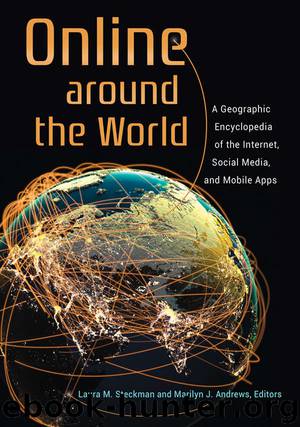Online around the World: A Geographic Encyclopedia of the Internet, Social Media, and Mobile Apps by Laura Steckman & Marilyn Andrews

Author:Laura Steckman & Marilyn Andrews [Steckman, Laura]
Language: eng
Format: azw3
Publisher: ABC-CLIO
Published: 2017-05-31T04:00:00+00:00
MONGOLIA
Mongolia is a Central Asian landlocked country bordered by China to the south and Russia to the north. Ulaanbaatar (UB), the capital and largest city, is home to about 45 percent of the country’s population of about 3 million people. Almost 60 percent of the UB population is under age 35, now consisting of a mix of city and rural-bred young residents, making Mongolia one of the youngest countries in the world in terms of its citizens.
Before 1990, Mongolia was a socialist country and a satellite of the Soviet Union. Western cultural and linguistic trends were considered a cruel weapon of capitalist ideology and were strictly banned by the ruling communist party—the Mongolian People’s Revolutionary Party (MPRP), which ruled from 1921 to 1990. The Russian language and culture were the only prevalent foreign elements in Mongolia. The communist authorities replaced the classic Mongolian Uyghur script with the Cyrillic alphabet in 1941, and Cyrillic Mongolian remains the official orthography (Rossabi 2005).
Following the collapse of the Soviet Union, Mongolia transformed from a socialist regime into a democracy, embracing a free-market economy in 1990. The authorities of communist Mongolia resigned without confrontation in 1990, marking the end of the seventy-year period of communist rule. This was the beginning of the new social, political, and economic order for the newly democratic nation. Mongolia opened up to the outside world, and new technology, media, computer, cable TV, urban radio stations, and the internet started circulating quickly across the nation. Mongolia witnessed major changes in its social, cultural, and linguistic lifestyle. Mongolians began getting heavily involved with internet, computer, and mobile phones in the context of their daily practices, including text messaging, chatting, surfing the web, playing video games, listening to music, and watching movies (Marsh 2009).
English and other languages, such as Japanese, Korean, Chinese, German, French, Spanish, Italian, and Turkish, have replaced Russian as Mongolians have become more connected to the world via the internet. Many of these languages are taught at all levels of Mongolian schools; at the national level, the country has been trying to attract quality English-language teachers from abroad. It is also reforming how its university teaching programs train instructors to provide exemplary teaching of all languages offered in Mongolian schools at the elementary, secondary, and tertiary levels (Munkhbat and Lkhagva 2015). The growth of English-language education, in particular, has also transferred to the professional realm, where most jobs require proficient English-language skills and frequently require job applicants to interview in English (Dovchin 2014).
Download
This site does not store any files on its server. We only index and link to content provided by other sites. Please contact the content providers to delete copyright contents if any and email us, we'll remove relevant links or contents immediately.
Periodization Training for Sports by Tudor Bompa(8170)
The Body: A Guide for Occupants by Bill Bryson(4974)
The MacArthur Bible Commentary by John MacArthur(4749)
The Sports Rules Book by Human Kinetics(4294)
What It Really Takes to Get Into Ivy League and Other Highly Selective Colleges by Hughes Chuck(3696)
Marijuana Grower's Handbook by Ed Rosenthal(3622)
The Sprouting Book by Ann Wigmore(3543)
The Martian by Andy Weir(3306)
Salt, Fat, Acid, Heat: Mastering the Elements of Good Cooking by Nosrat Samin(3108)
The Bread Bible by Rose Levy Beranbaum(3004)
Harry Potter 4 - Harry Potter and The Goblet of Fire by J.K.Rowling(2990)
Sapiens and Homo Deus by Yuval Noah Harari(2987)
The Marketing Plan Handbook: Develop Big-Picture Marketing Plans for Pennies on the Dollar by Robert W. Bly(2975)
Classic by Mary Berry(2942)
Martha Stewart's Baking Handbook by Martha Stewart(2796)
Screenplay: The Foundations of Screenwriting by Syd Field(2574)
The Plant Paradox by Dr. Steven R. Gundry M.D(2547)
50 Economics Classics by Tom Butler-Bowdon(2523)
The Cambridge Grammar Of The English Language by Rodney Huddleston Geoffrey K. Pullum(2382)
